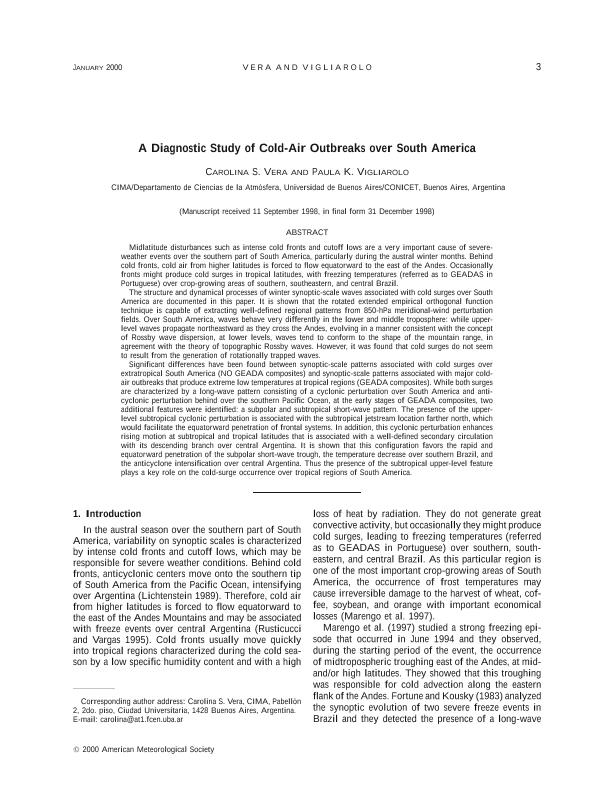Mostrar el registro sencillo del ítem
dc.contributor.author
Vera, Carolina Susana

dc.contributor.author
Vigliarolo, Paula Karina

dc.date.available
2021-10-08T02:49:24Z
dc.date.issued
2000-01
dc.identifier.citation
Vera, Carolina Susana; Vigliarolo, Paula Karina; A Diagnostic Study of Cold-Air Outbreaks over South America; Amer Meteorological Soc; Monthly Weather Review; 128; 1; 1-2000; 3-24
dc.identifier.issn
0027-0644
dc.identifier.uri
http://hdl.handle.net/11336/143230
dc.description.abstract
Midlatitude disturbances such as intense cold fronts and cutoff lows are a very important cause of severeweather events over the southern part of South America, particularly during the austral winter months. Behind cold fronts, cold air from higher latitudes is forced to flow equatorward to the east of the Andes. Occasionally fronts might produce cold surges in tropical latitudes, with freezing temperatures (referred as to GEADAS in Portuguese) over crop-growing areas of southern, southeastern, and central Brazil. The structure and dynamical processes of winter synoptic-scale waves associated with cold surges over South America are documented in this paper. It is shown that the rotated extended empirical orthogonal function technique is capable of extracting well-defined regional patterns from 850-hPa meridional-wind perturbation fields. Over South America, waves behave very differently in the lower and middle troposphere: while upperlevel waves propagate northeastward as they cross the Andes, evolving in a manner consistent with the concept of Rossby wave dispersion, at lower levels, waves tend to conform to the shape of the mountain range, in agreement with the theory of topographic Rossby waves. However, it was found that cold surges do not seem to result from the generation of rotationally trapped waves. Significant differences have been found between synoptic-scale patterns associated with cold surges over extratropical South America (NO GEADA composites) and synoptic-scale patterns associated with major coldair outbreaks that produce extreme low temperatures at tropical regions (GEADA composites). While both surges are characterized by a long-wave pattern consisting of a cyclonic perturbation over South America and anticyclonic perturbation behind over the southern Pacific Ocean, at the early stages of GEADA composites, two additional features were identified: a subpolar and subtropical short-wave pattern. The presence of the upperlevel subtropical cyclonic perturbation is associated with the subtropical jetstream location farther north, which would facilitate the equatorward penetration of frontal systems. In addition, this cyclonic perturbation enhances rising motion at subtropical and tropical latitudes that is associated with a well-defined secondary circulation with its descending branch over central Argentina. It is shown that this configuration favors the rapid and equatorward penetration of the subpolar short-wave trough, the temperature decrease over southern Brazil, and the anticyclone intensification over central Argentina. Thus the presence of the subtropical upper-level feature plays a key role on the cold-surge occurrence over tropical regions of South America.
dc.format
application/pdf
dc.language.iso
eng
dc.publisher
Amer Meteorological Soc

dc.rights
info:eu-repo/semantics/openAccess
dc.rights.uri
https://creativecommons.org/licenses/by-nc-sa/2.5/ar/
dc.subject
Cold-Air Outbreaks
dc.subject
South America
dc.subject
frost
dc.subject
synoptic-scale waves
dc.subject.classification
Meteorología y Ciencias Atmosféricas

dc.subject.classification
Ciencias de la Tierra y relacionadas con el Medio Ambiente

dc.subject.classification
CIENCIAS NATURALES Y EXACTAS

dc.title
A Diagnostic Study of Cold-Air Outbreaks over South America
dc.type
info:eu-repo/semantics/article
dc.type
info:ar-repo/semantics/artículo
dc.type
info:eu-repo/semantics/publishedVersion
dc.date.updated
2021-01-18T21:03:45Z
dc.identifier.eissn
0027-0644
dc.journal.volume
128
dc.journal.number
1
dc.journal.pagination
3-24
dc.journal.pais
Estados Unidos

dc.journal.ciudad
Boston
dc.description.fil
Fil: Vera, Carolina Susana. Consejo Nacional de Investigaciones Científicas y Técnicas. Oficina de Coordinación Administrativa Ciudad Universitaria. Centro de Investigaciones del Mar y la Atmósfera. Universidad de Buenos Aires. Facultad de Ciencias Exactas y Naturales. Centro de Investigaciones del Mar y la Atmósfera; Argentina
dc.description.fil
Fil: Vigliarolo, Paula Karina. Consejo Nacional de Investigaciones Científicas y Técnicas. Oficina de Coordinación Administrativa Ciudad Universitaria. Centro de Investigaciones del Mar y la Atmósfera. Universidad de Buenos Aires. Facultad de Ciencias Exactas y Naturales. Centro de Investigaciones del Mar y la Atmósfera; Argentina
dc.journal.title
Monthly Weather Review

dc.relation.alternativeid
info:eu-repo/semantics/altIdentifier/doi/http://documentacion.ideam.gov.co/cgi-bin/koha/opac-detail.pl?biblionumber=19282
dc.relation.alternativeid
info:eu-repo/semantics/altIdentifier/url/https://journals.ametsoc.org/view/journals/mwre/128/1/1520-0493_2000_128_0003_adsoca_2.0.co_2.xml
dc.relation.alternativeid
info:eu-repo/semantics/altIdentifier/doi/https://doi.org/10.1175/1520-0493(2000)128<0003:ADSOCA>2.0.CO;2
Archivos asociados
